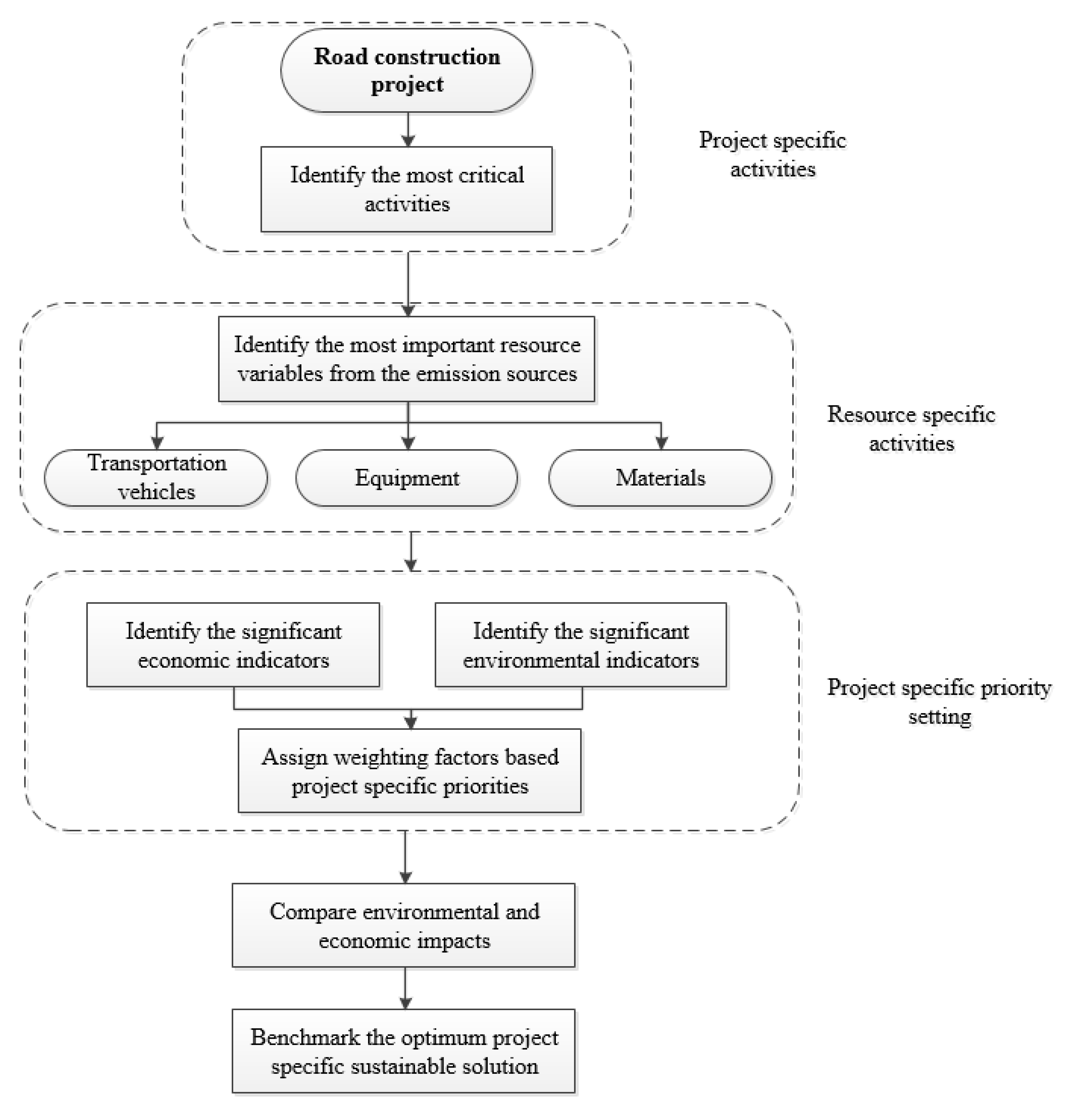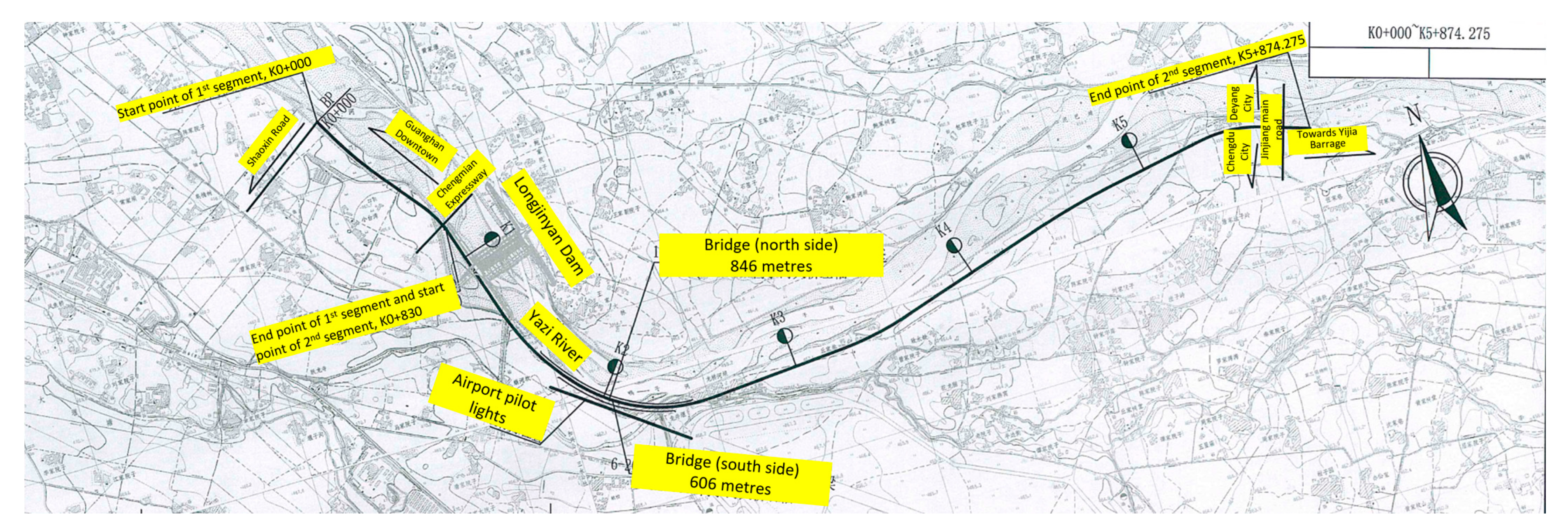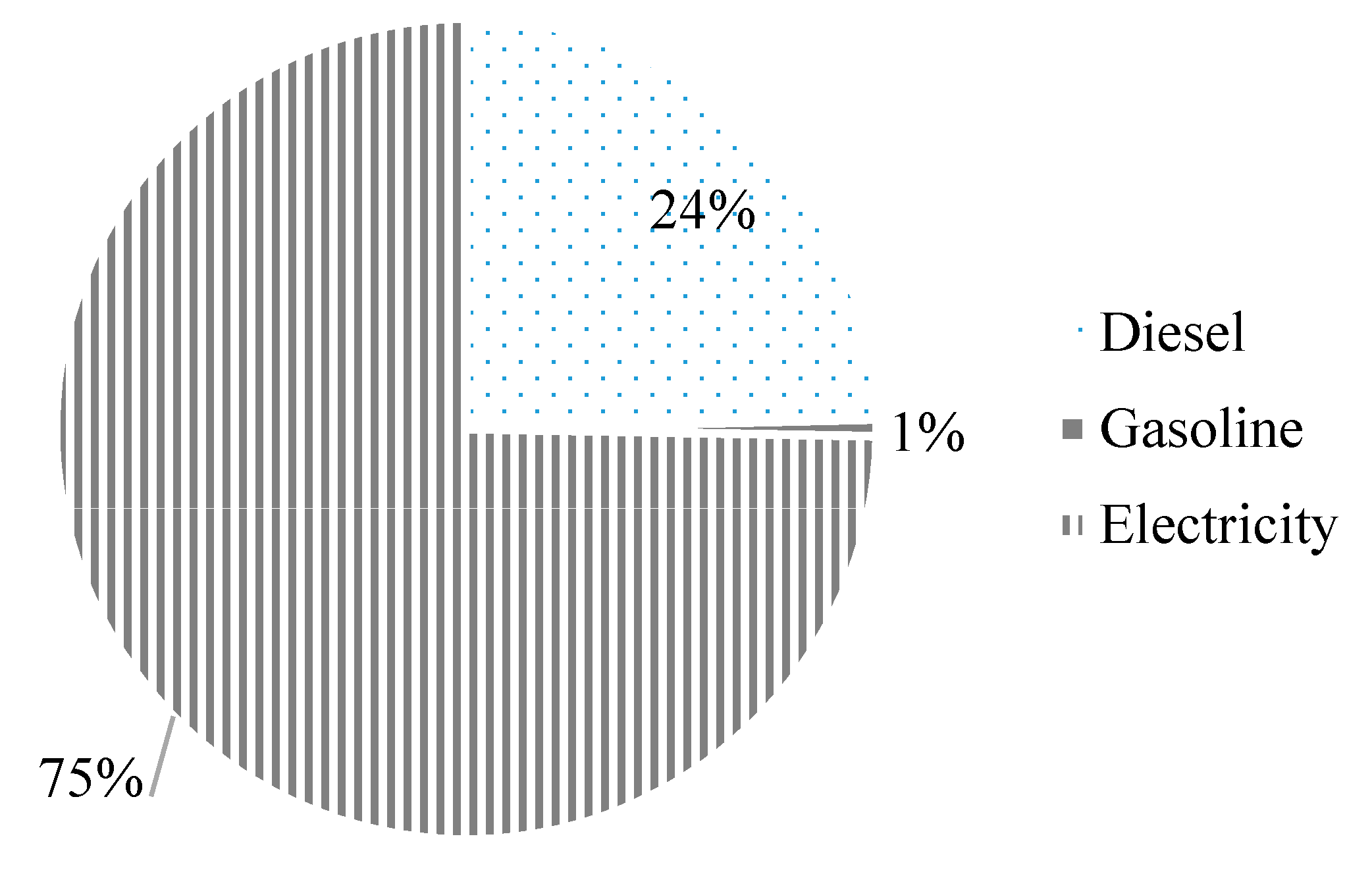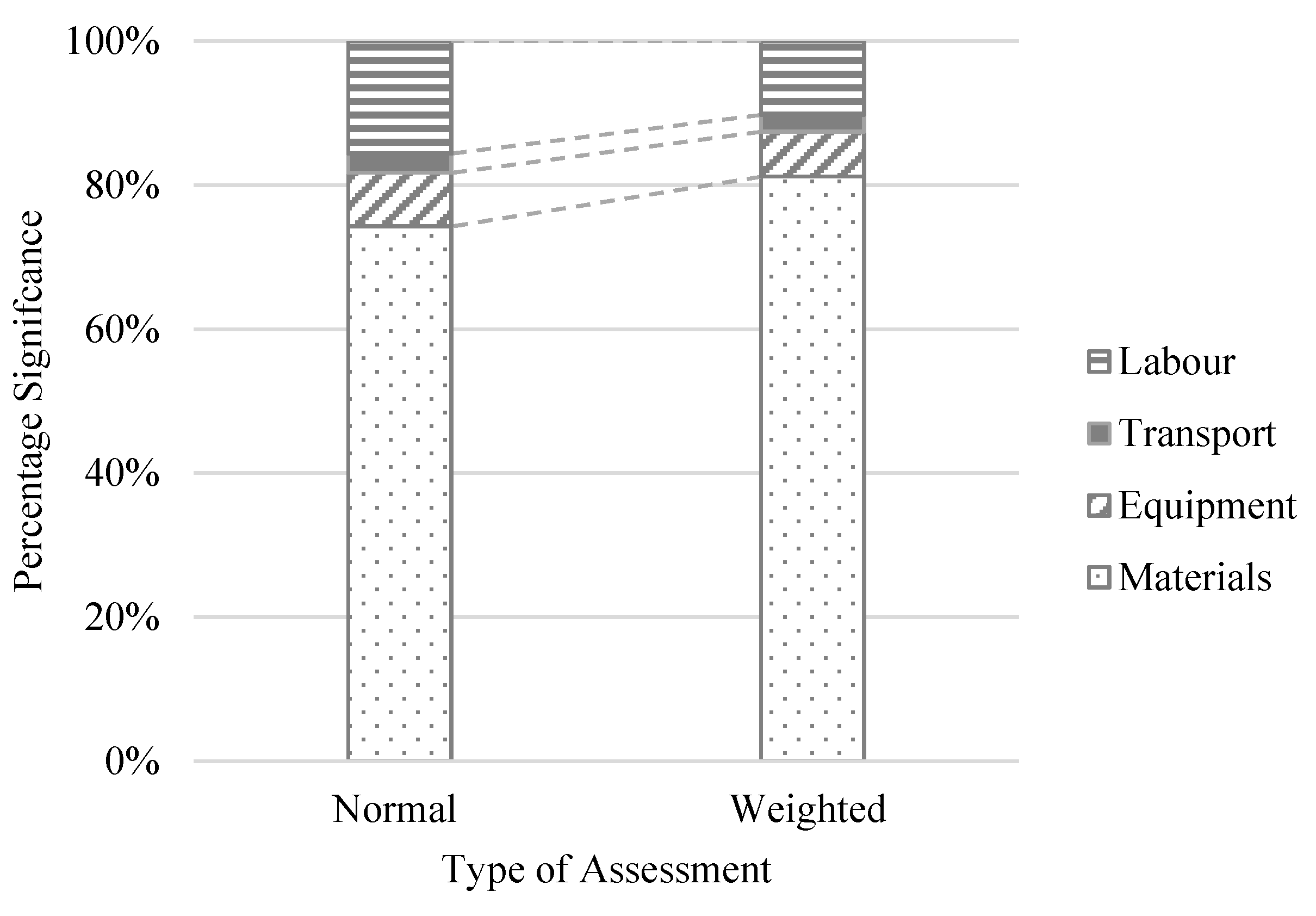Construction Cost and Carbon Emission Assessment of a Highway Construction—A Case towards Sustainable Transportation
Abstract
:1. Introduction
2. Background
3. Development of a Methodological Framework
4. Case Study
5. Research Methodology
5.1. Scope and Quantities Approach Selection
5.2. System Boundary for the Study
5.3. Functional Units for the Study
5.4. Models for Carbon Emissions
5.4.1. Emissions from Materials (Em)
5.4.2. Emissions from Construction Equipment (Eeq)
5.4.3. Emission Due to Transportation Vehicles
5.5. Models for Construction Cost Estimation
5.6. Weighting Factor (Wi,j) Determination
6. Results and Discussion
6.1. Project-Level Carbon Emissions and Costs Comparison
6.2. Carbon Emission and Cost Comparison from Each Component
6.2.1. Carbon Emissions and Cost from Materials
6.2.2. Carbon Emissions and Cost from Construction Equipment
6.2.3. Carbon Emissions and Cost from Transportation Vehicles
6.2.4. Cost of Labour
6.3. Weighted Results Comparison
7. Scenario Analysis
7.1. Scenario 1-Effect of Vehicle/Equipment Type
7.2. Scenario 2—Effect of Using Sustainable Materials
8. Conclusions, Recommendations and Future Research
Author Contributions
Funding
Institutional Review Board Statement
Informed Consent Statement
Data Availability Statement
Conflicts of Interest
References
- De Best, R. Highway Construction in the U.S.—Statistics & Facts. Available online: https://www.statista.com/topics/2148/highway-construction/ (accessed on 21 June 2021).
- Barandica, J.M.; Fernández-Sánchez, G.; Berzosa, Á.; Delgado, J.A.; Acosta, F.J. Applying life cycle thinking to reduce greenhouse gas emissions from road projects. J. Clean. Prod. 2013, 57, 79–91. [Google Scholar] [CrossRef]
- Anthonissen, J.; Van Troyen, D.; Braet, J. Using carbon dioxide emissions as a criterion to award road construction projects: A pilot case in Flanders. J. Clean. Prod. 2015, 102, 96–102. [Google Scholar] [CrossRef]
- Fernández-Sánchez, G.; Berzosa, Á.; Barandica, J.M.; Cornejo, E.; Serrano, J.M. Opportunities for GHG emissions reduction in road projects: A comparative evaluation of emissions scenarios using CO2NSTRUCT. J. Clean. Prod. 2015, 104, 156–167. [Google Scholar] [CrossRef]
- Sandanayake, M.; Kumanayake, R.; Peiris, A. Environmental impact assessments during construction stage at different geographic levels—A cradle-to-gate analysis of using sustainable concrete materials. Eng. Constr. Archit. Manag. 2021. [Google Scholar] [CrossRef]
- Sandanayake, M.; Zhang, G.; Setunge, S. Impediments affecting a comprehensive emission assessment at the construction stage of a building. Int. J. Constr. Manag. 2019, 1–11. [Google Scholar] [CrossRef]
- Luo, W.; Sandanayake, M.; Zhang, G. Direct and indirect carbon emissions in foundation construction—Two case studies of driven precast and cast-in-situ piles. J. Clean. Prod. 2019, 211, 1517–1526. [Google Scholar] [CrossRef]
- Sandanayake, M.; Zhang, G.; Setunge, S.; Luo, W.; Li, C.-Q. Estimation and comparison of environmental emissions and impacts at foundation and structure construction stages of a building—A case study. J. Clean. Prod. 2017, 151, 319–329. [Google Scholar] [CrossRef]
- Zhang, G.; Sandanayake, M.; Setunge, S.; Li, C.; Fang, J. Selection of emission factor standards for estimating emissions from diesel construction equipment in building construction in the Australian context. J. Environ. Manag. 2017, 187, 527–536. [Google Scholar] [CrossRef] [PubMed]
- Sandanayake, M.; Zhang, G.; Setunge, S.; Li, C.-Q.; Fang, J. Models and method for estimation and comparison of direct emissions in building construction in Australia and a case study. Energy Build. 2016, 126, 128–138. [Google Scholar] [CrossRef]
- Martín-Morales, M.; Zamorano, M.; Ruiz-Moyano, A.; Valverde-Espinosa, I. Characterization of recycled aggregates construction and demolition waste for concrete production following the Spanish Structural Concrete Code EHE-08. Constr. Build. Mater. 2011, 25, 742–748. [Google Scholar] [CrossRef]
- Jin, R.; Li, B.; Elamin, A.; Wang, S.; Tsioulou, O.; Wanatowski, D. Experimental investigation of properties of concrete containing recycled construction wastes. Int. J. Civ. Eng. 2018, 16, 1621–1633. [Google Scholar] [CrossRef] [Green Version]
- Ossa, A.; García, J.; Botero, E. Use of recycled construction and demolition waste (CDW) aggregates: A sustainable alternative for the pavement construction industry. J. Clean. Prod. 2016, 135, 379–386. [Google Scholar] [CrossRef]
- Kim, B.; Lee, H.; Park, H.; Kim, H. Greenhouse gas emissions from onsite equipment usage in road construction. J. Constr. Eng. Manag. 2012, 138, 982–990. [Google Scholar] [CrossRef]
- Sandanayake, M.; Zhang, G.; Setunge, S.; Thomas, C. Environmental Emissions of Construction Equipment Usage in Pile Foundation Construction Process—A Case Study. In Proceedings of the 19th International Symposium on Advancement of Construction Management and Real Estate; Shen, L., Ye, K., Mao, C., Eds.; Springer: Berlin/Heidelberg, Germany, 2015; pp. 327–339. [Google Scholar]
- Sandanayake, M.; Gunasekara, C.; Law, D.; Zhang, G.; Setunge, S.; Wanijuru, D. Sustainable criterion selection framework for green building materials—An optimisation based study of fly-ash Geopolymer concrete. Sustain. Mater. Technol. 2020, 25, e00178. [Google Scholar] [CrossRef]
- Finkbeiner, M. The new international standards for life cycle assessment: ISO 14040 and ISO 14044. Int. J. Life Cycle Assess. 2006, 11, 80–85. [Google Scholar] [CrossRef]
- Arvanitoyannis, I.S. ISO 14040: Life cycle assessment (LCA)–principles and guidelines. Waste Manag. Food Ind. 2008, 3, 97–132. [Google Scholar]
- Pujadas-Gispert, E.; Sanjuan-Delmás, D.; de la Fuente, A.; Moonen, S.P.G.; Josa, A. Environmental analysis of concrete deep foundations: Influence of prefabrication, concrete strength, and design codes. J. Clean. Prod. 2020, 244, 118751. [Google Scholar] [CrossRef]
- Ghisellini, P.; Ripa, M.; Ulgiati, S. Exploring environmental and economic costs and benefits of a circular economy approach to the construction and demolition sector. A literature review. J. Clean. Prod. 2018, 178, 618–643. [Google Scholar] [CrossRef]
- Van der Lugt, P.; Van den Dobbelsteen, A.; Janssen, J. An environmental, economic and practical assessment of bamboo as a building material for supporting structures. Constr. Build. Mater. 2006, 20, 648–656. [Google Scholar] [CrossRef]
- Fregonara, E.; Giordano, R.; Rolando, D.; Tulliani, J.-M. Integrating Environmental and Economic Sustainability in New Building Construction and Retrofits. J. Urban Technol. 2016, 23, 3–28. [Google Scholar] [CrossRef]
- Sandanayake, M.S. Models and Toolkit to Estimate and Analyse the Emissions and Environmental Impacts of Building Construction. Ph.D. Thesis, Rmit University, Melbourne, Australia, 2016. [Google Scholar]
- Reza, B.; Sadiq, R.; Hewage, K. Emergy-based life cycle assessment (Em-LCA) for sustainability appraisal of infrastructure systems: A case study on paved roads. Clean Technol. Environ Policy 2014, 16, 251–266. [Google Scholar] [CrossRef]
- Rahman, S.; Vanier, D. Life cycle cost analysis as a decision support tool for managing municipal infrastructure. In CIB 2004 Triennial Congress; National Research Council (NRC): Ottawa, ON, Canada, 2004. [Google Scholar]
- Kariyawasam, S.; McGovern, M.; Wilson, C. Partial information and complex development decisions: Illustrations from infrastructure projects. Environ. Impact Assess. Rev. 2019, 78, 106281. [Google Scholar] [CrossRef]
- Hasan, U.; Whyte, A.; Al Jassmi, H. Critical review and methodological issues in integrated life-cycle analysis on road networks. J. Clean. Prod. 2019, 206, 541–558. [Google Scholar] [CrossRef]
- Ruiz, A.; Guevara, J. Environmental and economic impacts of road infrastructure development: Dynamic considerations and policies. J. Manag. Eng. 2020, 36, 04020006. [Google Scholar] [CrossRef]
- Wang, X.; Duan, Z.; Wu, L.; Yang, D. Estimation of carbon dioxide emission in highway construction: A case study in southwest region of China. J. Clean. Prod. 2015, 103, 705–714. [Google Scholar] [CrossRef]
- Liu, Y.; Wang, Y.; Li, D. Estimation and uncertainty analysis on carbon dioxide emissions from construction phase of real highway projects in China. J. Clean. Prod. 2017, 144, 337–346. [Google Scholar] [CrossRef]
- Krantz, J.; Lu, W.; Johansson, T.; Olofsson, T. Analysis of alternative road construction staging approaches to reduce carbon dioxide emissions. J. Clean. Prod. 2017, 143, 980–988. [Google Scholar] [CrossRef]
- Sandanayake, M.; Zhang, G.; Setunge, S. Estimation of environmental emissions and impacts of building construction—A decision making tool for contractors. J. Build. Eng. 2019, 21, 173–185. [Google Scholar] [CrossRef]
- Sandanayake, M.; Luo, W.; Zhang, G. Direct and indirect impact assessment in off-site construction—A case study in China. Sustain. Cities Soc. 2019, 48, 101520. [Google Scholar] [CrossRef]
- Sandanayake, M.; Lokuge, W.; Zhang, G.; Setunge, S.; Thushar, Q. Greenhouse gas emissions during timber and concrete building construction —A scenario based comparative case study. Sustain. Cities Soc. 2018, 38, 91–97. [Google Scholar] [CrossRef] [Green Version]
- Guggemos, A.A.; Horvath, A. Decision-support tool for assessing the environmental effects of constructing commercial buildings. J. Archit. Eng. 2006, 12, 187–195. [Google Scholar] [CrossRef]
- Yan, H.; Shen, Q.; Fan, L.C.; Wang, Y.; Zhang, L. Greenhouse gas emissions in building construction: A case study of One Peking in Hong Kong. Build. Environ. 2010, 45, 949–955. [Google Scholar] [CrossRef] [Green Version]
- Wang, L.; Xue, X.; Zhao, Z.; Wang, Z. The impacts of transportation infrastructure on sustainable development: Emerging trends and challenges. Int. J. Environ. Res. Public Health 2018, 15, 1172. [Google Scholar] [CrossRef] [Green Version]
- Li, D.; Wang, Y.; Liu, Y.; Sun, S.; Gao, Y. Estimating life-cycle CO2 emissions of urban road corridor construction: A case study in Xi’an, China. J. Clean. Prod. 2020, 255, 120033. [Google Scholar] [CrossRef]
- Marzouk, M.; Abdelkader, E.M.; El-zayat, M.; Aboushady, A. Assessing environmental impact indicators in road construction projects in developing countries. Sustainability 2017, 9, 843. [Google Scholar] [CrossRef] [Green Version]
- Earon, R.; Olofsson, B.; Renman, G. Initial effects of a new highway section on soil and groundwater. Water Air Soil Pollut. 2012, 223, 5413–5432. [Google Scholar] [CrossRef]
- Vanthomme, H.; Kolowski, J.; Nzamba, B.S.; Alonso, A. Hypothesis-driven and field-validated method to prioritize fragmentation mitigation efforts in road projects. Ecol. Appl. 2015, 25, 2035–2046. [Google Scholar] [CrossRef] [PubMed]
- Vijay, R.; Kushwaha, V.K.; Mardikar, T.; Labhasetwar, P.K. Impact of highway construction on water bodies: A geospatial assessment. Environ. Monit. Assess. 2017, 189, 1–9. [Google Scholar] [CrossRef]
- Carpenter, A.C.; Gardner, K.H.; Fopiano, J.; Benson, C.H.; Edil, T.B. Life cycle based risk assessment of recycled materials in roadway construction. Waste Manag. 2007, 27, 1458–1464. [Google Scholar] [CrossRef] [PubMed]
- Nicuţǎ, A.M.; Frunzǎ, R. Environmental impact assessment for traditional versus recycled road asphalt mixtures. Environ. Eng. Manag. J. 2013, 12, 575–585. [Google Scholar] [CrossRef]
- Maghool, F.; Arulrajah, A.; Du, Y.J.; Horpibulsuk, S.; Chinkulkijniwat, A. Environmental impacts of utilizing waste steel slag aggregates as recycled road construction materials. Clean Technol. Environ. Policy 2017, 19, 949–958. [Google Scholar] [CrossRef]
- Pacheco-Torres, R.; Varela, F. Mechanical performance of cement-stabilised soil containing recycled glass as road base layer. Road Mater. Pavement Des. 2019, 21, 2247–2263. [Google Scholar] [CrossRef]
- Veropalumbo, R.; Russo, F.; Viscione, N.; Biancardo, S.A.; Oreto, C. Investigating the rheological properties of hot bituminous mastics made up using plastic waste materials as filler. Constr. Build. Mater. 2021, 270, 121394. [Google Scholar] [CrossRef]
- Oreto, C.; Veropalumbo, R.; Viscione, N.; Biancardo, S.A.; Russo, F. Investigating the environmental impacts and engineering performance of road asphalt pavement mixtures made up of jet grouting waste and reclaimed asphalt pavement. Environ. Res. 2021, 198, 111277. [Google Scholar] [CrossRef]
- Chen, J.; Zhao, F.; Liu, Z.; Ou, X.; Hao, H. Greenhouse gas emissions from road construction in China: A province-level analysis. J. Clean. Prod. 2017, 168, 1039–1047. [Google Scholar] [CrossRef]
- Park, K.; Hwang, Y.; Seo, S.; Seo, H. Quantitative assessment of environmental impacts on life cycle of highways. J. Constr. Eng. Manag. 2003, 129, 25–31. [Google Scholar] [CrossRef]
- Treloar, G.J.; Love, P.E.; Crawford, R.H. Hybrid life-cycle inventory for road construction and use. J. Constr. Eng. Manag. 2004, 130, 43–49. [Google Scholar] [CrossRef]
- Hanson, C.S.; Noland, R.B. Greenhouse gas emissions from road construction: An assessment of alternative staging approaches. Transp. Res. Part D Transp. Environ. 2015, 40, 97–103. [Google Scholar] [CrossRef]
- Norris, G.A. Integrating life cycle cost analysis and LCA. Int. J. Life Cycle Assess 2001, 6, 118–120. [Google Scholar] [CrossRef]
- Lee, J.; Edil, T.B.; Benson, C.H.; Tinjum, J.M. Building Environmentally and Economically Sustainable Transportation Infrastructure: Green Highway Rating System. J. Constr. Eng. Manag. 2013, 139, A4013006. [Google Scholar] [CrossRef]
- Ozcan-Deniz, G.; Zhu, Y. Multi-objective optimization of greenhouse gas emissions in highway construction projects. Sustain. Cities Soc. 2017, 28, 162–171. [Google Scholar] [CrossRef] [Green Version]
- France-Mensah, J.; O’Brien, W.J. Developing a sustainable pavement management plan: Tradeoffs in road condition, user costs, and greenhouse gas emissions. J. Manag. Eng. 2019, 35, 04019005. [Google Scholar] [CrossRef]
- Guo, M.; Murphy, R.J. LCA data quality: Sensitivity and uncertainty analysis. Sci. Total Environ. 2012, 435–436, 230–243. [Google Scholar] [CrossRef]
- Bribián, I.Z.; Uson, A.A.; Scarpellini, S. Life cycle assessment in buildings: State-of-the-art and simplified LCA methodology as a complement for building certification. Build. Environ. 2009, 44, 2510–2520. [Google Scholar] [CrossRef]
- Guggemos, A.A. Environmental Impacts of On-Site Construction Processes: Focus on Structural Frames; University of California, Berkeley: Berkeley, CA, USA, 2003. [Google Scholar]
- Guggemos, A.A.; Horvath, A. Comparison of environmental effects of steel-and concrete-framed buildings. J. Infrastruct. Syst. 2005, 11, 93–101. [Google Scholar] [CrossRef]
- Junnila, S.; Horvath, A.; Guggemos, A. Life-Cycle Assessment of Office Buildings in Europe and the United States. J. Infrastruct. Syst. 2006, 12, 10–17. [Google Scholar] [CrossRef]
- Mao, C.; Shen, Q.; Shen, L.; Tang, L. Comparative study of greenhouse gas emissions between off-site prefabrication and conventional construction methods: Two case studies of residential projects. Energy Build. 2013, 66, 165–176. [Google Scholar] [CrossRef] [Green Version]
- Hong, J.; Shen, G.Q.; Feng, Y.; Lau, W.S.-t.; Mao, C. Greenhouse gas emissions during the construction phase of a building: A case study in China. J. Clean. Prod. 2015, 103, 249–259. [Google Scholar] [CrossRef] [Green Version]
- Wu, P.; Mao, C.; Wang, J.; Song, Y.; Wang, X. A decade review of the credits obtained by LEED v2. 2 certified green building projects. Build. Environ. 2016, 102, 167–178. [Google Scholar] [CrossRef]
- Zuo, J.; Pullen, S.; Rameezdeen, R.; Bennetts, H.; Wang, Y.; Mao, G.; Zhou, Z.; Du, H.; Duan, H. Green building evaluation from a life-cycle perspective in Australia: A critical review. Renew. Sustain. Energy Rev. 2017, 70, 358–368. [Google Scholar] [CrossRef]
- Liu, G.; Chen, R.; Xu, P.; Fu, Y.; Mao, C.; Hong, J. Real-time carbon emission monitoring in prefabricated construction. Autom. Constr. 2020, 110, 102945. [Google Scholar] [CrossRef]
- Hossain, M.U.; Poon, C.S. Comparative LCA of wood waste management strategies generated from building construction activities. J. Clean. Prod. 2018, 177, 387–397. [Google Scholar] [CrossRef]
- Sandanayake, M.; Zhang, G.; Setunge, S. A comparative method of air emission impact assessment for building construction activities. Environ. Impact Assess. Rev. 2018, 68, 1–9. [Google Scholar] [CrossRef]
- Xing, S.; Xu, Z.; Jun, G. Inventory analysis of LCA on steel- and concrete-construction office buildings. Energy Build. 2008, 40, 1188–1193. [Google Scholar] [CrossRef]
- Luo, Z.; Yang, L.; Liu, J. Embodied carbon emissions of office building: A case study of China’s 78 office buildings. Build. Environ. 2016, 95, 365–371. [Google Scholar] [CrossRef] [Green Version]
- Li, L.; Chen, K. Quantitative assessment of carbon dioxide emissions in construction projects: A case study in Shenzhen. J. Clean. Prod. 2017, 141, 394–408. [Google Scholar] [CrossRef]
- Peng, C. Calculation of a building’s life cycle carbon emissions based on Ecotect and building information modeling. J. Clean. Prod. 2016, 112 Pt 1, 453–465. [Google Scholar] [CrossRef]
- Lewis, P.; Leming, M.; Frey, H.C.; Rasdorf, W. Assessing effects of operational efficiency on pollutant emissions of nonroad diesel construction equipment. Transp. Res. Rec. 2011, 2233, 11–18. [Google Scholar] [CrossRef]
- Hermann, B.; Kroeze, C.; Jawjit, W. Assessing environmental performance by combining life cycle assessment, multi-criteria analysis and environmental performance indicators. J. Clean. Prod. 2007, 15, 1787–1796. [Google Scholar] [CrossRef] [Green Version]
- Sandanayake, M.; Zhang, G.; Setunge, S. Environmental emissions at foundation construction stage of buildings—Two case studies. Build. Environ. 2016, 95, 189–198. [Google Scholar] [CrossRef]
- González, V.; Echaveguren, T. Exploring the environmental modeling of road construction operations using discrete-event simulation. Autom. Constr. 2012, 24, 100–110. [Google Scholar] [CrossRef]








| Material | Sand | Coarse Sand | Pebble and Gravel | Basalt Gravel | Cement | Steel | Asphalt | Asphalt Concrete |
|---|---|---|---|---|---|---|---|---|
| Average Distance (km) | 30 | 30 | 30 | 240 | 50 | 30 | 20 | 40 |
| Stage | Description | Total Amount (RMB) |
|---|---|---|
| 1 | General provisions | 1,244,754.00 |
| 2 | Subgrade | 27,746,172.00 |
| 3 | Pavement | 18,246,957.00 |
| 4 | Bridges, culverts | 29,297,371.00 |
| 5 | Tunnel | 4,790,904.00 |
| 6 | Safety facilities and pre-buried pipelines | 9,582,793.00 |
| 7 | Landscaping and environmental protection | 224,980.00 |
| J = Emissions | Em | Eeq | ET | - | Wi,j | Wi,j × Total |
| Em | 1.00 | 1.83 | 1.33 | - | 0.43 | 1.00 |
| Eeq | 0.56 | 1.00 | 0.67 | - | 0.23 | 1.01 |
| ET | 0.78 | 1.56 | 1.00 | - | 0.34 | 1.02 |
| Total | 2.34 | 4.39 | 3.00 | - | 1.00 | 3.04 |
| J = Cost | Cm | Ceq | CT | CL | Wi,j | Wi,j × Total |
| Cm | 1.00 | 2.00 | 1.67 | 3.7 | 0.39 | 1.08 |
| Ceq | 0.5 | 1.00 | 1.5 | 3.33 | 0.26 | 1.06 |
| CT | 1 | 0.72 | 1.00 | 3.67 | 0.27 | 1.20 |
| CL | 0.28 | 0.31 | 0.28 | 1.00 | 0.08 | 0.95 |
| Total | 2.78 | 4.03 | 4.45 | 11.7 | 1.00 | 4.28 |
| Stage | Cost for Each Component at Each Construction Stage (in Chinese Yuan, RMB) | ||||||
| 1 | 2 | 3 | 4 | 5 | 6 | 7 | |
| Material | 1,024,449 | 24,478,216 | 11,731,977 | 18,219,122 | 2,232,109 | 9,079,098 | 195,723 |
| Equipment | 45,454 | 1,235,709 | 894,264 | 3,984,370 | 502,014 | 81,769 | - |
| Transport | 128,798 | 796,039 | 491,939 | 771,042 | 146,491 | 52,441 | 4959 |
| Labour | 46,053 | 985,173 | 5,062,992 | 5,774,642 | 1,841,81 | 360,770 | 24,295 |
| Total | 1,244,754 | 27,495,137 | 18,181,172 | 28,749,176 | 4,722,433 | 9,574,078 | 224,980 |
| % total | 1.4% | 30.5% | 20.2% | 31.9% | 5.2% | 10.6% | 0.2% |
| Stage | Carbon Emissions for Each Component at Each Construction Stage (tCO2-eq) | ||||||
| 1 | 2 | 3 | 4 | 5 | 6 | 7 | |
| Material | 768.5 | 21,331.9 | 7444.4 | 15,547.9 | 2065.6 | 18,393.4 | 54.7 |
| Equipment | 12.0 | 696.8 | 242.4 | 832.6 | 1104.6 | 90.1 | - |
| Transport | 3262.6 | 2549.4 | 7179.7 | 1529.9 | 382.9 | 124.3 | 14.3 |
| Total | 4043.1 | 24,578.1 | 14,866.5 | 17,910.4 | 3553.0 | 18,607.9 | 69.0 |
| % total | 4.8% | 29.4% | 17.8% | 21.4% | 4.2% | 22.3% | 0.1% |
| Material Type | Carbon Emissions (tCO2-eq) | Cost (RMB) |
|---|---|---|
| Concrete | 17,789.1 | 11,715,186 |
| Steel | 22,153.9 | 15,008,296 |
| Iron | 131.8 | 253,200 |
| Asphalt | 10.0 | 1,516,090 |
| Brick | 6.4 | 8397 |
| Cement | 4020.1 | 1,377,640 |
| Soil and gravel | 4383.2 | 26,672,910 |
| Clay | 140.0 | 159,224 |
| Glass | 2.2 | 5086 |
| Paint | 1765.8 | 413,696 |
| Sand | 1221.8 | 226,635 |
| Rubber | 485.6 | 362,550 |
| Aluminium | 65.9 | 240,000 |
| Other | 13,430.8 | 9,013,688 |
| Equipment Type | Fuel Type | Carbon Emissions (tCO2-eq) | Cost (RMB) |
|---|---|---|---|
| Excavators | Diesel | 67.5 | 283,876 |
| Drilling rigs | Electric | 577.7 | 2,455,398 |
| Cranes | Diesel, Gasoline and Electricity | 119.4 | 580,015 |
| Asphalt paving related | Diesel, Gasoline and Electricity | 31.7 | 209,397 |
| Graders | Diesel | 95.9 | 325,614 |
| Loaders | Diesel | 72.1 | 186,414 |
| Rollers | Diesel | 243.6 | 800,183 |
| Road sprinklers | Gasoline and Electricity | 5.9 | 51,394 |
| Soil mixers | Electric | 35.4 | 106,656 |
| Small machines | Electric | 1421.7 | 1,362,969 |
| Minor (other) | Diesel | 68.7 | 375,581 |
| Pumps | Electric | 1.2 | 6105 |
| Transport Vehicle | Carbon Emissions (tCO2-eq) | Cost (RMB) |
|---|---|---|
| Truck (2 t) | 153.3 | 58,203 |
| Truck (4 t) | 70.2 | 22,960 |
| Truck (8 t) | 2.9 | 834 |
| Truck (10 t) | 105.0 | 32,110 |
| Truck (15 t) | 2.0 | 713 |
| Dump truck (12 t) | 4129.4 | 1,188,698 |
| Dump truck (15 t) | 564.5 | 175,602 |
| Liquid asphalt transporter | 27.1 | 11,367 |
| Concrete truck (10 t) | 9998.0 | 1,843,423.8 |
| Truck Type | Transportation Emissions (t-CO2-eq) | % Difference | Total Emissions (t-CO2-eq) | % Difference |
| 10-t concrete truck | 15,043.1 | - | 83,628.2 | - |
| 5-t concrete truck | 18,044.3 | 19.95% | 86,629.4 | 3.59% |
| 15-t concrete truck | 13,227.0 | −12.07% | 81,812.1 | −2.17% |
| Truck Type | Transportation Cost (RMB) | % Difference | Total Cost (RMB) | % Difference |
| 10-t concrete truck | 2,391,710 | - | 90,191,731 | - |
| 5-t concrete truck | 2,662,489 | 11.32% | 90,462,510 | 0.30% |
| 15-t concrete truck | 3,333,911 | 39.39% | 91,133,932 | 1.04% |
Publisher’s Note: MDPI stays neutral with regard to jurisdictional claims in published maps and institutional affiliations. |
© 2021 by the authors. Licensee MDPI, Basel, Switzerland. This article is an open access article distributed under the terms and conditions of the Creative Commons Attribution (CC BY) license (https://creativecommons.org/licenses/by/4.0/).
Share and Cite
Luo, W.; Sandanayake, M.; Zhang, G.; Tan, Y. Construction Cost and Carbon Emission Assessment of a Highway Construction—A Case towards Sustainable Transportation. Sustainability 2021, 13, 7854. https://doi.org/10.3390/su13147854
Luo W, Sandanayake M, Zhang G, Tan Y. Construction Cost and Carbon Emission Assessment of a Highway Construction—A Case towards Sustainable Transportation. Sustainability. 2021; 13(14):7854. https://doi.org/10.3390/su13147854
Chicago/Turabian StyleLuo, Wenkai, Malindu Sandanayake, Guomin Zhang, and Yongtao Tan. 2021. "Construction Cost and Carbon Emission Assessment of a Highway Construction—A Case towards Sustainable Transportation" Sustainability 13, no. 14: 7854. https://doi.org/10.3390/su13147854
APA StyleLuo, W., Sandanayake, M., Zhang, G., & Tan, Y. (2021). Construction Cost and Carbon Emission Assessment of a Highway Construction—A Case towards Sustainable Transportation. Sustainability, 13(14), 7854. https://doi.org/10.3390/su13147854






_Zhang.png)


